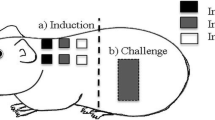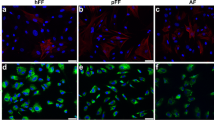Abstract
Allogeneic cultured dermal substitute (CDS) was prepared by plating cultured fibroblasts on a two-layered spongy matrix of hyaluronic acid and atelocollagen, followed by culturing for 1 week. The resulting fresh CDS was then cryopreserved in a freezer at −152°C in accordance with conventional procedures. Fresh CDS was rinsed thoroughly with lactated Ringer’s solution to remove fetal bovine serum (FBS) and was then used in the clinical study, whereas cryopreserved CDS was thawed and then rinsed with lactated Ringer’s solution to remove cryoprotectant and FBS. The present study was designed to compare the efficacy of fresh and cryopreserved CDS in promoting reepithelialization at donor sites leaving behind split-thickness skin autografts. Fourteen donor sites were used for this comparative study. There were no differences in the period of complete re-epithelialization between the fresh and cryopreserved CDS. The results of this comparative study thus suggest that cryopreserved CDS is able to maintain the same level of potency to promote re-epithelialization as fresh CDS. This indicates that, although the release of growth factors is suppressed to some extent during the course of cryopreserving, thawing, and rinsing procedures, it is still sufficient to promote re-epithelialization.
Similar content being viewed by others
References
Yamada N, Shioya N, Kuroyanagi Y. Evaluation of an allogeneic cultured dermal substitute composed of fibroblasts within a spongy collagen matrix as a wound dressing. Scand J Plast Reconstr Surg 1995;29:211–219
Tanaka M, Nakakita N, Kuroyanagi Y. Allogeneic cultured dermal substitute composed of spongy collagen containing fibroblasts: evaluation in animal tests. J Biomater Sci Polymer Edn 1999;10:433–453
Yamada N, Uchinuma E, Kuroyanagi Y. Clinical evaluation of an allogeneic cultured dermal substitute composed of fibroblasts within a spongy collagen matrix. Scand J Plast Reconstr Surg 1999;33:147–154
Yamada N, Uchinuma E, Kuroyanagi Y. Comparative evaluation of allogeneic cultured dermal substitute and allogeneic cultured epidermal sheet in promoting wound healing. J Jpn PRS 1999;19:610–616
Kuroyanagi Y, Yamada N, Yamashita R, Uchinuma E. Tissue-engineered product: allogeneic cultured dermal substitute composed of spongy collagen with fibroblasts. Artif Organs 2001;25:180–186
Kubo K, Kuroyanagi Y. Spongy matrix of hyaluronic acid and collagen as a cultured dermal substitute: evaluation in an animal test. J Artif Organs 2003;6:64–70
Kubo K, Kuroyanagi Y. Characterization of cultured dermal substitute composed of spongy matrix of hyaluronic acid and collagen combined with fibroblasts. J Artif Organs 2003;6:138–144
Kubo K, Kuroyanagi Y. Development of a cultured dermal substitute composed of a spongy matrix of hyaluronic acid and atelocollagen combined with fibroblasts: fundamental evaluation. J Biomater Sci Polymer Edn 2003;14:625–641
Kashiwa N, Ito O, Ueda T, Kubo K, Matsui H, Kuroyanagi Y. Treatment of full-thickness skin defect with concomitant grafting of sixfold extended mesh auto-skin and allogeneic cultured dermal substitute. Artif Organs 2004;28:444–450
Ohtani T, Okamoto K, Kaminaka C, Kishi T, Sakurane M, Yamamoto Y, Ueda K, Kubo K, Kuroyanagi Y, Furukawa F. Digital gangrene associated with idiopathic hypereosinophilia: treatment with allogeneic cultured dermal substitute (CDS). Eur J Dermatol 2004;14:168–171
Moroi Y, Fujita S, Fukagawa S, Mashino T, Goto T, Masuda T, Urabe K, Kubo K, Matsui H, Kagawa S, Kuroyanagi Y, Furue M. Clinical evaluation of allogeneic cultured dermal substitutes for intractable skin ulcers after tumor resection. Eur J Dermatol 2004;14:172–176
Hasegawa T, Suga Y, Mizoguchi M, Ikeda S, Ogawa H, Kubo K, Matsui H, Kagawa S, Kuroyanagi Y. Clinical trial of allogeneic cultured dermal substitute for the treatment of intractable skin ulcers in 3 patients with recessive dystrophic epidermolysis bullosa. J Am Acad Dermatol 2004;50:803–804
Hasegawa T, Suga Y, Mizoguchi M, Muramatsu S, Mizuno Y, Ogawa H, Kubo K, Kuroyanagi Y. An allogeneic cultured dermal substitute suitable for treating intractable skin ulcers and large skin defects prior to autologous skin grafting: three case reports. J Dermatol 2005;32:715–720
Hasegawa T, Suga Y, Mizoguchi M, Muramatsu S, Mizuno Y, Haruna K, Ikeda S, Kuroyanagi Y, Ogawa H. Intractable venous leg ulcer treated successfully with allogeneic cultured dermal substitute. Scand J Plast Reconstr Surg Hand Surg 2007;41:326–328
Yonezawa M, Tanizaki H, Inoguchi N, Ishida M, Katoh M, Tachibana T, Miyachi Y, Kubo K, Kuroyanagi Y. Clinical study with allogeneic cultured dermal substitutes for chronic leg ulcers. Int J Dermatol 2007;46:36–42
Yamada N, Uchinuma E, Kuroyanagi Y. Clinical trial of allogeneic cultured dermal substitutes for intractable skin ulcers of the lower leg. J Artif Organs 2008;11:100–103
Kubo K, Kuroyanagi Y. Development of cultured dermal substitute composed of spongy matrix of hyaluronic acid and atelocollagen combined with fibroblasts: cryopreservation. Artif Organs 2004;28:182–188
Kubo K, Kuroyanagi Y. The possibility of long-term cryopreservation of cultured dermal substitute. Artif Organs 2005;29:800–805
Kuroyanagi Y, Kubo K, Matsui H, Kim HJ, Numari S, Mabuchi Y, Kagawa S. Establishment of banking system for allogeneic cultured dermal substitute. Artif Organs 2004;28:13–21
Kubo K, Kuroyanagi Y. Effects of vascular endothelial growth factor released from cultured dermal substitute on proliferation of vascular endothelial cells in vitro. J Artif Organs 2003;6:267–272
Kubo K, Kuroyanagi Y. A study of cytokines released from fibroblasts in cultured dermal substitute. Artif Organs 2005;29:845–849
Author information
Authors and Affiliations
Corresponding author
Rights and permissions
About this article
Cite this article
Yamada, N., Uchinuma, E., Matsumoto, Y. et al. Comparative evaluation of re-epithelialization promoted by fresh or cryopreserved cultured dermal substitute. J Artif Organs 11, 221–224 (2008). https://doi.org/10.1007/s10047-008-0428-1
Received:
Accepted:
Published:
Issue Date:
DOI: https://doi.org/10.1007/s10047-008-0428-1




